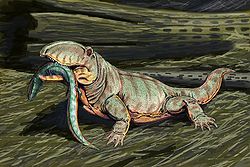- Ophiacodon
-
Ophiacodon
Temporal range: Late Carboniferous–Early Permian
Ophiacodon mirus Scientific classification Kingdom: Animalia Phylum: Chordata Superclass: Tetrapoda Class: Synapsida Order: Pelycosauria (unranked): Eupelycosauria Family: Ophiacodontidae Genus: Ophiacodon
Marsh, 1878Species - Ophiacodon grandis
- Ophiacodon hilli
- Ophiacodon major
- Ophiacodon mirus
- Ophiacodon navajovicus
- Ophiacodon retroversus
- Ophiacodon uniformis
Ophiacodon (meaning "snake tooth") was a large pelycosaur. Its fossils were found in Joggins, Nova Scotia, Canada.
Ophiacodon was at least two meters in length, and the largest species were up to 3.6 metres (12 ft). It is estimated to have weighed from 30 to 50 kilograms (66 to 110 lb). The size of the various species increased during the Early Permian epoch until its extinction.[1] It was a specialized member of the ophiacodontid family.
The skull was deep, with long jaws, and provided with sharp teeth. Ophiacodon may have eaten fishes in streams and ponds[1], although the high narrow skull would seem to argue against such a lifestyle.
Ophiacodon is related to other animals in the family Ophiacodontidae, such as Archaeothyris. Relatives of the Ophiacodontidae seem to be ancestral to the therapsids, which gave rise to mammals.[2]
Ophiacodon was featured in the Paleoworld episode titled "Tail Of A Sail".
See also
- List of synapsids
- Permian tetrapods
- Evolution of mammals
References
- ^ a b Palmer, D., ed (1999). The Marshall Illustrated Encyclopedia of Dinosaurs and Prehistoric Animals. London: Marshall Editions. p. 186. ISBN 1-84028-152-9.
- ^ Maddin, H.C., Evans, D.C., Reisz, R.R. (2006). "An Early Permian Varanodontine Varanopid (Synapsida:Eupelycosauria) from the Richards Spur Locality, Oklahoma." J Vertebrate Paleontology, 26(4): 957-966.
- Pelycosaurs
- Permian synapsids
- Prehistoric synapsids of North America
- Synapsid stubs
Wikimedia Foundation. 2010.



